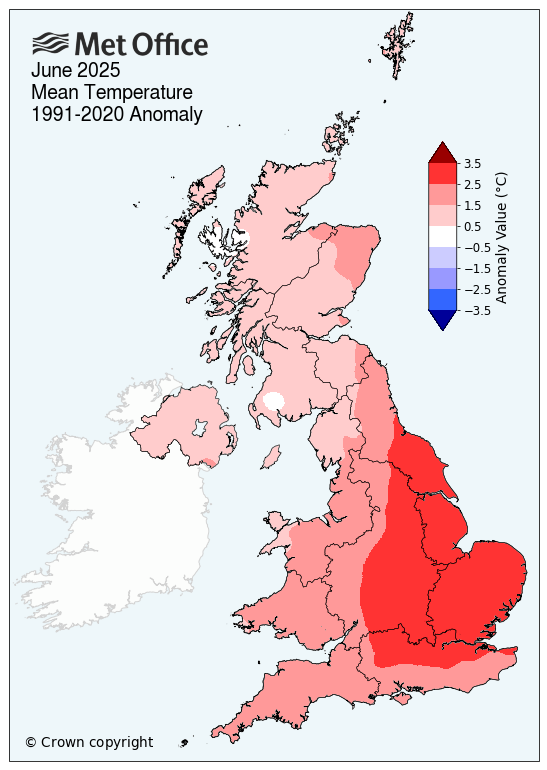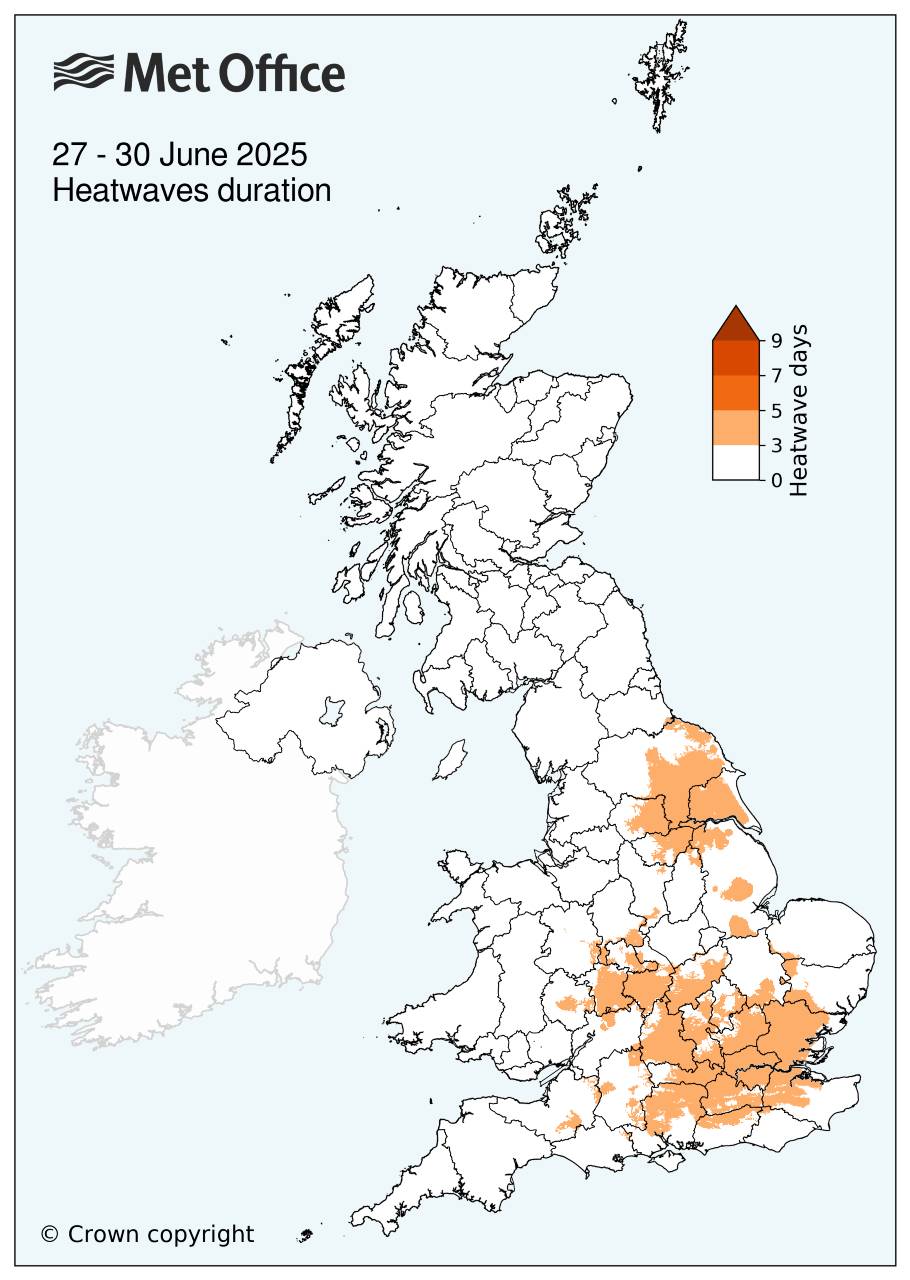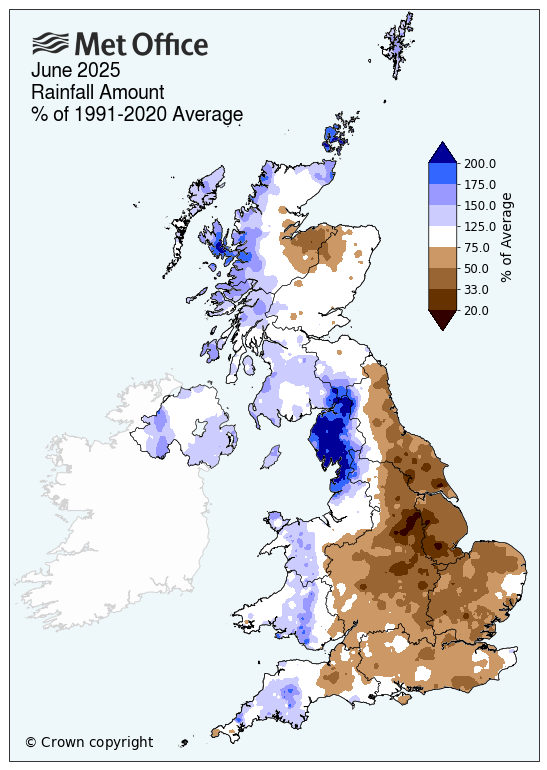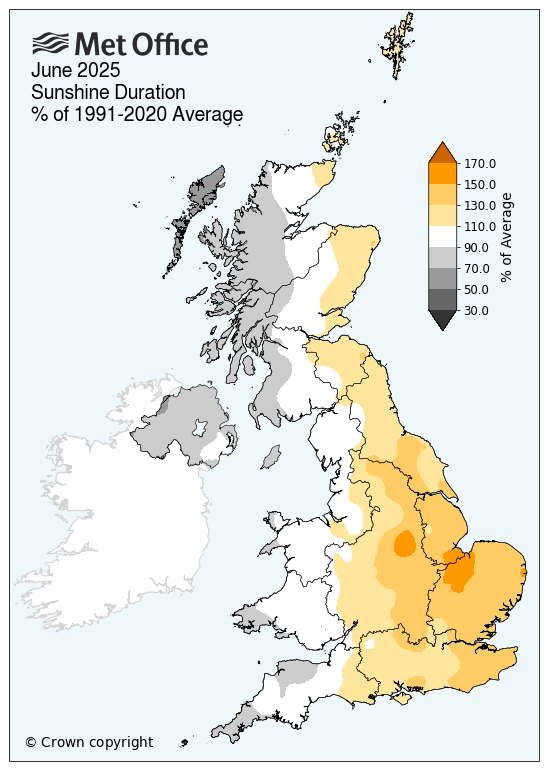England’s warmest June on record and the UK’s second warmest since 1884
Author: Press Office
13:22 (UTC+1) on Tue 1 Jul 2025
England has had its warmest June on record, while the UK has experienced its second warmest since the series began in 1884, according to provisional Met Office statistics.
This follows a record-breaking spring, which was officially the warmest and sunniest spring on record for the UK. June continued that trend, marked by two heatwaves and some high temperatures to see off the month.
Two heatwaves and historic highs
According to provisional data, the UK’s mean temperature of 15.2°C for June was the second highest on record for the month, only surpassed by June 2023, which recorded 15.8°C. England recorded its warmest June on record with a mean temperature of 16.9°C, while Wales experienced its third warmest June since the series began in 1884.
The east and southeast of England especially, saw the most pronounced warmth, with East Anglia’s mean temperature 3°C above its long-term meteorological average for June.

Average daily maximum temperatures were also well-above the long-term meteorological average for June, with England recording its third highest and the UK its sixth highest average temperature since 1884. The UK, England and Wales also all had their highest average minimum temperatures for June since 1884. Northern Ireland recorded its second and Scotland its fourth.
June’s first heatwave occurred during the third week of the month, with heatwave criteria being met in many areas across England and Wales.

This map shows the places to reach heatwave criteria from 16-21 June 2025.
The temperatures then broke with thunderstorms and showers across large parts of the UK, before high temperatures returned to close out the month. This time though, the heat was more concentrated on the very far south and east of England.

This map shows the places to reach heatwave criteria from 27-30 June 2025.
Met Office Climate Scientist, Dr Amy Doherty, said: "While we’ve not conducted formal climate attribution studies into June 2025’s two heatwaves, past studies have shown it is virtually certain that human influence has increased the occurrence and intensity of extreme heat events such as this.
"Numerous climate attribution studies have shown that human influence increased the chance that specific extreme heat events would occur, such as the summer of 2018 and July 2022. Our Met Office climate projections indicate that hot spells will become more frequent in our future climate, particularly over the southeast of the UK. Temperatures are projected to rise in all seasons, but the heat would be most intense in summer."
How does this year compare to 1976?
The summer of 1976 remains one of the most notable in UK weather history and differs from June 2025 due to the longevity of the heat. During 1976, multiple locations across England recorded heatwave spells lasting over two weeks.
Read: The UK's longest heatwave events and where they happened
June 2025 has been warmer than June 1976, with June 1976 now sitting as the fourth warmest on record for the UK and third warmest for England.
Looking ahead
As the climate continues to change, the UK is likely to see more frequent and intense heatwaves. A new Met Office study highlights how UK heatwaves could become longer and hotter due to escalating climate trends, with the chance of exceeding 40°C in the UK accelerating at pace.
Understanding past events helps us prepare for future extremes. The Met Office continues to monitor and analyse temperature trends to provide accurate forecasts and timely warnings, helping communities stay safe during periods of extreme heat.
Rainfall: Just above average for the UK, but with regional variation
Rainfall across the UK concluded just above average (103%), but regional differences were evident. Northern Ireland, Wales and Scotland all saw at least 20% more rainfall than average, with England the only nation recording less, receiving only 80%. There was also a clear north-south split in England, with the north recording 98% of its average, and the south just 68%.
Regionally, Orkney experienced its wettest June since the series began in 1836, and Cumbria its fourth. Honister Pass in the Lake District fells recorded 499.4mm of rain for the month, compared to 20mm or less in the driest areas of eastern England.

Sunshine: bright skies for many
Sunshine levels were above average across the UK (112%) although no national records were broken. England was particularly sunny (124%), meanwhile, Wales, Scotland and Northern Ireland all failed to reach their long-term average sunshine for the month.

Read: How do we know when weather records are broken?
|
Provisional June 2025 stats |
Mean temp (°C) |
Rainfall (mm/%) |
Sunshine (hours/ %) |
|||
|
Actual |
91/20 anom |
Actual |
91/20 anom |
Actual |
91/20 anom |
|
|
UK |
15.2 | 1.9 | 79.5 | 103 | 192.1 | 112 |
|
England |
16.9 | 2.5 | 51.9 | 80 | 223.4 | 124 |
|
Wales |
15.3 | 1.8 | 114.0 | 124 | 173.9 | 98 |
|
Scotland |
12.7 | 1.0 | 112.0 | 121 | 140.3 | 96 |
|
Northern Ireland |
14.1 | 1.1 | 103.9 | 128 | 122.7 | 82 |





